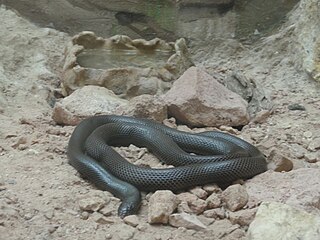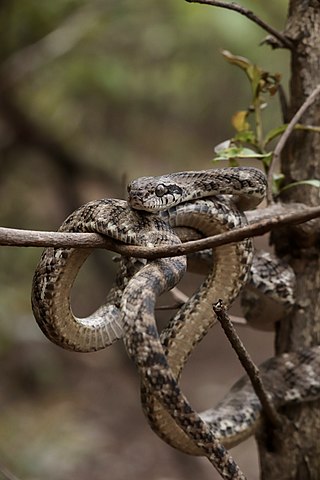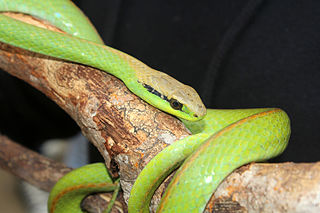
Colubridae is a family of snakes. With 249 genera, it is the largest snake family. The earliest species of the family date back to the Oligocene epoch. Colubrid snakes are found on every continent except Antarctica.

Boiga is a large genus of rear-fanged, mildly venomous snakes, known commonly as cat-eyed snakes or simply cat snakes, in the family Colubridae. Species of the genus Boiga are native to southeast Asia, India, and Australia, but due to their extremely hardy nature and adaptability, have spread to many other suitable habitats around the world. There are 38 recognized species in the genus. According to the study done by Jiří Smíd regarding Old World cat snakes, the ancestor of the cat snake originated in Africa, from where it diversified and expanded to other countries. Despite this diversity however, the different species have very similar needs in terms of temperature and precipitation.

The Atractaspididae (atractaspidids) are a family of venomous snakes found in Africa and the Middle East, commonly called mole vipers, stiletto snakes, or burrowing asps. Currently, 12 genera are recognized.

A snake skeleton consists primarily of the skull, vertebrae, and ribs, with only vestigial remnants of the limbs.

The boomslang is a large, highly venomous snake in the family Colubridae.

Clelia is a genus of snakes, one of three genera with species with the common name mussurana or musurana It is a genus of large snakes in the family Colubridae. The genus is endemic to Central America and South America, and species of Clelia are found from southern Mexico to Brazil. They specialize in ophiophagy, i.e., they attack and eat other snakes. Currently seven species are recognized as being valid. They have other popular names in various countries, such as zopilota in Central America and cribo on some Caribbean islands.

The banded cat-eyed snake is a species of mildly venomous, rear-fanged, colubrid snake, endemic to the New World.

Boiga forsteni, also known commonly as Forsten's cat snake, is a species of mildly venomous rear-fanged snake in the family Colubridae. The species is endemic to South Asia.

Ahaetulla, commonly referred to as Asian vine snakes or Asian whip snakes, is a genus of colubrid snakes distributed throughout tropical Asia. They are considered by some scientists to be mildly venomous and are what is commonly termed as 'rear-fanged' or more appropriately, opisthoglyphous, meaning their enlarged teeth or fangs, intended to aid in venom delivery, are located in the back of the upper jaw, instead of in the front as they are in vipers or cobras. As colubrids, Ahaetulla do not possess a true venom gland or a sophisticated venom delivery system. The Duvernoy's gland of this genus, homologous to the venom gland of true venomous snakes, produces a secretion which, though not well studied, is considered not to be medically significant to humans.

Hoplocephalus is a genus of venomous snakes in the family Elapidae. The genus is endemic to Australia. Three species are recognized.

Pseudonaja nuchalis, the northern brown snake or gwardar, is a species of very fast, highly venomous elapid snake native to Australia. Its colour and pattern are rather variable, depending largely on its location.

Boiga barnesii is a species of cat snake endemic to Sri Lanka. It is known as Barnes' cat snake in English and panduru mapila-පදුරු මාපිලා in Sinhala. It is a member of the snake family Colubridae. It is distributed in the lowlands and midlands up to approximately 600 m (2,000 ft) above sea level, with known localities include Matale, Kandy, Gannoruwa, Gampola, Ambagamuwa, Balangoda, Labugama and Sinharaja Rain Forest. Barnes' cat snake is mainly a forest-dwelling species but may occasionally be found in human habitats. It is the smallest cat snake in Sri Lanka and grows up to a maximum of about 600 mm (24 in) in snout-vent length. Being a nocturnal and an arboreal hunter, it mainly feeds on agamid lizards and geckos. The day time is usually spent inside a tree hole or a crevice. It’s a very timid and a mildly venomous snake and rarely attempts to bite.

Telescopus semiannulatus, commonly known as the common tiger snake, tiger cat snake, western tiger snake, or eastern tiger snake is a species of rear-fanged colubrid snake. It is widespread in central, eastern, and southern Africa.

Philodryas olfersii is a species of venomous snake in the family Colubridae. The species is endemic to South America.

Boiga kraepelini, commonly known as the square-headed cat snake, Kelung cat snake, or Taiwanese tree snake is a species of mildly venomous, rear-fanged snake in the family Colubridae. The species is endemic to East Asia and Southeast Asia. Its specific name, kraepelini, honours Karl Kraepelin, a German naturalist. The common name, Kelung cat snake, refers to its type locality, Keelung in northern Taiwan.

Telescopus beetzi, commonly known as Beetz's tiger snake, is a species of snake in the family Colubridae. The species is native to southern Africa.

The Arabian cat snake, large-eyed cat snake, or Israeli cat snake is a species of snake of the family Colubridae.
Telescopus rhinopoma is a species of rear-fanged mildly venomous snake in the family Colubridae. The species is found in the Middle East (Iran), Afghanistan, Pakistan desert areas like Bahawalpur, and Central Asia (Turkmenistan).
The western keeled snake is a species of snake in the family Pseudaspididae. It is native to western Namibia, southwestern Angola, and southwestern Zambia, and is the only member of the genus Pythonodipsas.
Telescopus obtusus, commonly known as the Egyptian cat snake, is a species of snake in the family Colubridae.


















